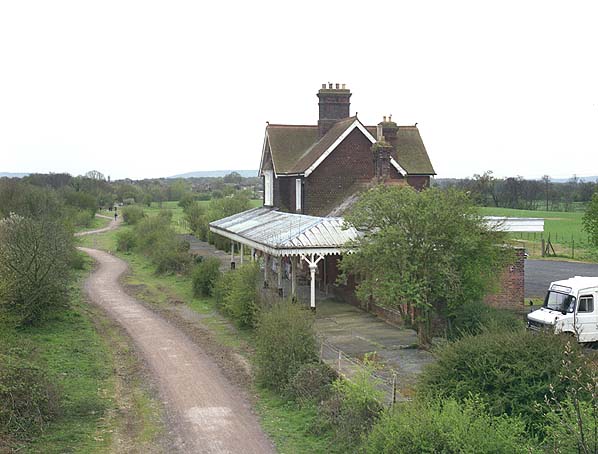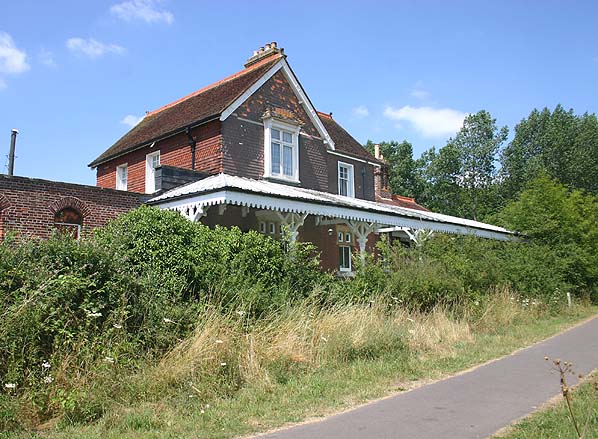|
Notes: Hellingly was the only station on the Cuckoo line with
only one platform which was sited on the up side of the line. A small goods yard with two sidings and a 5-ton capacity crane was accessed from the south with the sidings running behind the platform. At this time the yard only handles small goods and parcels. By the 1920s a third siding had been added between the two original sidings. This passed through an unusual goods shed without any walls and consisting of a pitched corrugated iron roof supported on metal pillars and then passed a dock. With the expansion of the yard a full range of goods traffic was handled. Goods traffic was withdrawn from the station
from 12 September 1964.
 Hellingly Station features in the 1964 film Smokescreen starring Peter Vaughan and John Carson. The film was shot almost entirely in the Brighton area. At one point, Hellingly Station is mentioned as the possible route for the suspect to have escaped the area. The two investigators (Vaughan and Carson) visit the station and meet the stationmaster Derek Guyler (played by Deryck Guyler) who tells them the station is about to close, as is the whole line. The line did, in fact, close about a year after the film was made. Hellingly Station features in the 1964 film Smokescreen starring Peter Vaughan and John Carson. The film was shot almost entirely in the Brighton area. At one point, Hellingly Station is mentioned as the possible route for the suspect to have escaped the area. The two investigators (Vaughan and Carson) visit the station and meet the stationmaster Derek Guyler (played by Deryck Guyler) who tells them the station is about to close, as is the whole line. The line did, in fact, close about a year after the film was made.
Just south of the station there was a siding that led to nearby
Hellingly Mental Hospital. It had no connection with the LBSCR
except that a small wooden platform was constructed without
a canopy opposite Hellingly's only platform. Traffic to the
hospital could use it between the hours of 6am and 6pm and then
provided due notice was given to the railway company. The railway
was used to convey building material, stores and so forth to
the hospital and occasionally visitors and staff. For this there
was a 12-seater four-wheeled tramcar.
In 1903 the mile-length line was electrified using the hospital's
own generated current at 500 volts DC. The wire was suspended
from brackets supported by metal poles spaced out alongside
the track.
 The line closed to passenger traffic in 1931 and the platform
was removed in 1932. By 1954 goods traffic was down to about
one a day but the line lingered on until March 1959 when it
was finally abandoned although there was at least 1 enthusiast
'special' after that date. Click here for pictures of the remaining
features of the Hellingly Hospital Railway in 2005. The hospital, including the engine shed, were demolished in 2011 and the site is now occupied by housing. The line closed to passenger traffic in 1931 and the platform
was removed in 1932. By 1954 goods traffic was down to about
one a day but the line lingered on until March 1959 when it
was finally abandoned although there was at least 1 enthusiast
'special' after that date. Click here for pictures of the remaining
features of the Hellingly Hospital Railway in 2005. The hospital, including the engine shed, were demolished in 2011 and the site is now occupied by housing.
BRIEF HISTORY OF EASTBOURNE
- TUNBRIDGE WELLS (CUCKOO) LINE
The `Cuckoo Line' from Polegate to Eridge was completed in two
stages. Initially a route from Polegate to Hailsham was opened
on 14th May 1849 and a line south to Eastbourne opened to traffic
on the same day. These lines followed only three years after
a route had been completed east from Brighton via Lewes and
Polegate to St. Leonards.
The remainder of the route northwards from Hailsham to Eridge
was completed some 31 years. In 1873, local business interests
promoted a Bill for a 3' gauge line from Tunbridge Wells to
Polegate. Little progress was made in raising the required capital
and the LBSC stepped in, obtaining an Act in 1876 giving them
authority to extend their Hailsham line to Eridge where it joined
the Uckfield - Groombridge Junction line (opened in 1868). The
South Eastern Railway was to be given a share in the receipts
and running powers over the line into Eastbourne.
The 7 1/2 miles of single track was opened between Hailsham
and Heathfield on 5th April 1880 and the 9 3/4 miles on to Eridge
on 1st September that year.
At Redgate Junction, south of Eridge it joined the route from
Uckfield to Groombridge and both lines ran in parallel to Tunbridge
Wells and to London via the Oxted line. When the Uckfield line
was doubled in 1894 the Heathfield line north of Redgate Junction
became the down line.
The name `Cuckoo' was adopted by the railwaymen themselves.
This relates to the old Sussex legend that on the 14th April
annually the first cuckoo of summer is released at Heathfield
Fair.
 By 1904 services on the Brighton lines had
assumed a pattern that was to remain radically unaltered
until 1933. There were a total of 83 workings between Groombridge
and Tunbridge Wells West where trains went on to three destinations,
Three Bridges, Brighton via the Uckfield line and Eastbourne
via the Cuckoo line. By 1904 services on the Brighton lines had
assumed a pattern that was to remain radically unaltered
until 1933. There were a total of 83 workings between Groombridge
and Tunbridge Wells West where trains went on to three destinations,
Three Bridges, Brighton via the Uckfield line and Eastbourne
via the Cuckoo line.
By 1925 the single track spur from Tunbridge Wells West to
Central was little used with four daily trains to Brighton and
two to Uckfield. Three of these carried through carriages for
the Cuckoo line which were detached at Eridge. By the 1950's
this had improved and in 1956, 58 passenger trains and two freights
used the spur making it, for that year, the busiest section
of single track in the country.
The main goods stations on the Cuckoo line were at Heathfield
and Hailsham, the other stations handled little more than the
occasional wagon of coal.
 Despite a new timetable being introduced in the 1950's with
one train an hour on the Cuckoo line, it was not to survive
the Beeching cuts. In 1965 a survey revealed that there were
only 250 passengers a day using the line of which only 23 were
season ticket holders. Any attempt to promote the line was halted
under the Beeching plan and a new timetable was introduced with
long waits between connecting trains designed to deter passengers
from using the service. Despite a new timetable being introduced in the 1950's with
one train an hour on the Cuckoo line, it was not to survive
the Beeching cuts. In 1965 a survey revealed that there were
only 250 passengers a day using the line of which only 23 were
season ticket holders. Any attempt to promote the line was halted
under the Beeching plan and a new timetable was introduced with
long waits between connecting trains designed to deter passengers
from using the service.

The Cuckoo line was closed to passengers north of Hailsham on
14th June 1965. Freight
trains continued from Hailsham to Heathfield until 26th April
1968 when a bridge became damaged and repair was considered
uneconomic and not carried out. Hailsham closed completely on
9th September 1968 and with this the final stretch of Cuckoo
line had gone.
Although the line between Groombridge and Tunbridge Wells West
was also proposed for closure this remained open but there was
no future investment in the line and by the early 1980's the
track and signaling needed replacing.
 With the planned removal
of Grove Junction during the upgrade of the Tonbridge - Hastings
line British Rail decided they could no longer justify keeping
the line open and announced closure of the line from 16th May
1983. Once again there were strong objections but these were
outweighed by British Rail's cost argument. They estimated that
to upgrade the infrastructure, while retaining the existing
services, would give a £175,000 loss per year and the
Secretary of State confirmed closure of the line on 6th July
1985. With the planned removal
of Grove Junction during the upgrade of the Tonbridge - Hastings
line British Rail decided they could no longer justify keeping
the line open and announced closure of the line from 16th May
1983. Once again there were strong objections but these were
outweighed by British Rail's cost argument. They estimated that
to upgrade the infrastructure, while retaining the existing
services, would give a £175,000 loss per year and the
Secretary of State confirmed closure of the line on 6th July
1985.
Grove Junction was removed the day after closure but the line
from Eridge to Tunbridge Wells remained in use until 10th August
1985 when the depot was closed.
 Shortly after closure the Tunbridge Wells and Eridge Railway
Preservation Society was formed with an aim of reinstating the
passenger service on the line. The Society acquired the line
in the early 1990's and by winter 1996 they had refurbished
half a mile of track and were able to run a steam service from
their base on part of the old Tunbridge Wells West station site.
TWERPS later merged with the North Downs Steam Railway at Dartford,
Kent. The line is now known as The
Spa Valley Railways, a name chosen as the result of a competition. Shortly after closure the Tunbridge Wells and Eridge Railway
Preservation Society was formed with an aim of reinstating the
passenger service on the line. The Society acquired the line
in the early 1990's and by winter 1996 they had refurbished
half a mile of track and were able to run a steam service from
their base on part of the old Tunbridge Wells West station site.
TWERPS later merged with the North Downs Steam Railway at Dartford,
Kent. The line is now known as The
Spa Valley Railways, a name chosen as the result of a competition.
The Spa Valley
Railway now runs for 3 1/2 miles to a new station at Groombridge
with an intermediate station at High Rocks built by the owner
of the High Rocks Inn and Restaurant.
 Between 1992 - 1994 the section of line between Polegate and
Heathfield was reopened by the county council as a footpath
and cycleway known as the Cuckoo
Trail. There are proposals to extend northwards from Heathfield
and as part of this extension Heathfield Tunnel has been restored
and lit and the 'Millennium Gates' fitted to the south portal. Between 1992 - 1994 the section of line between Polegate and
Heathfield was reopened by the county council as a footpath
and cycleway known as the Cuckoo
Trail. There are proposals to extend northwards from Heathfield
and as part of this extension Heathfield Tunnel has been restored
and lit and the 'Millennium Gates' fitted to the south portal.
Further reading: The
Hellingly Hospital Railway by Peter A Harding - published
by the author in 1989 - ISBN 0 9509414 5 X
Tickets from Michael Stewart. Route map drawn by Alan Young
Click here
for other web sites
To see the other
stations on the Eastbourne - Tunbridge Wells West line click
on the station name: Tunbridge
Wells West, High
Rocks Halt, Groombridge,
Eridge, Rotherfield
& Mark Cross, Mayfield,
Heathfield, Horam,
Hailsham, Polegate,
Hampden Park
& Eastbourne
Click here
for pictures of surviving features of the Hellingly Hospital
railway in 2005 |

1.jpg)
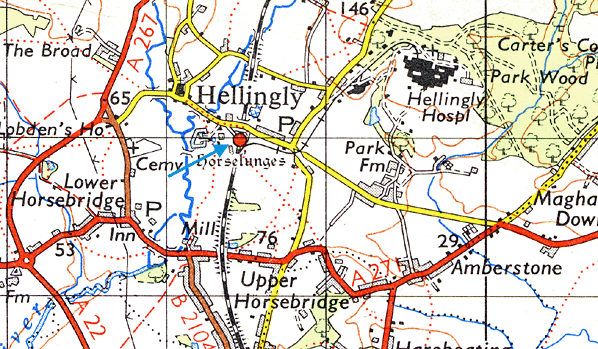
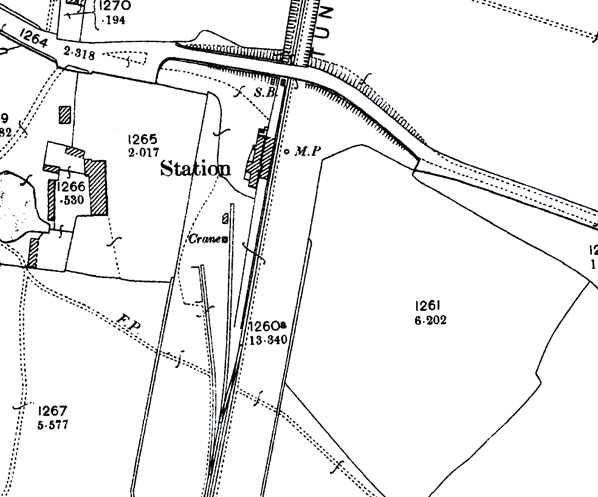
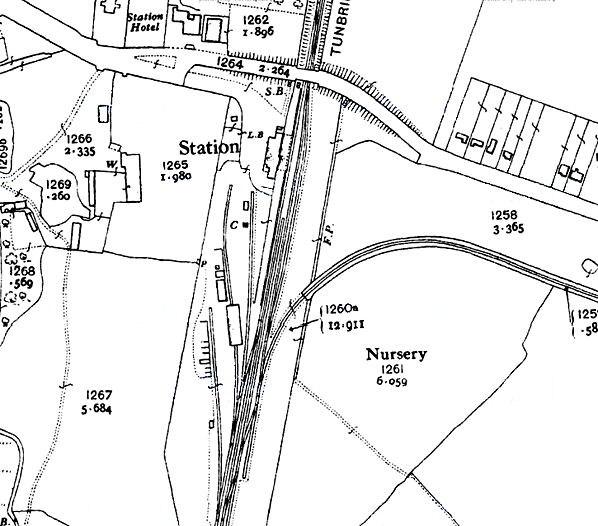
10.jpg)
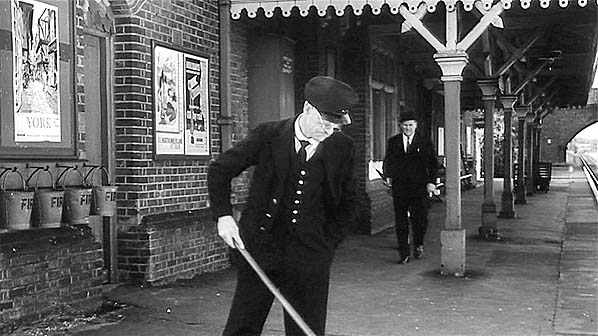
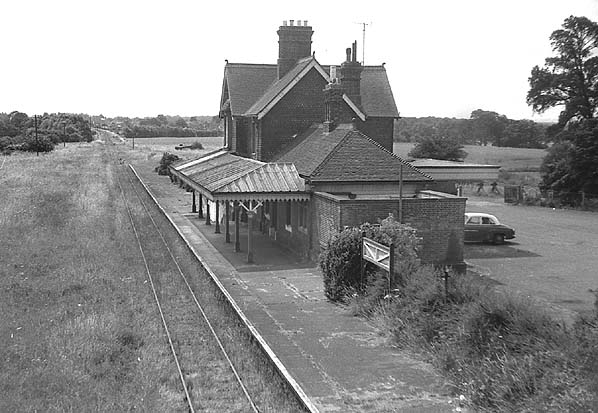
 Home
Page
Home
Page

 Hellingly Station features in the 1964 film
Hellingly Station features in the 1964 film  The line closed to passenger traffic in 1931 and the platform
was removed in 1932. By 1954 goods traffic was down to about
one a day but the line lingered on until March 1959 when it
was finally abandoned although there was at least 1 enthusiast
'special' after that date. Click
The line closed to passenger traffic in 1931 and the platform
was removed in 1932. By 1954 goods traffic was down to about
one a day but the line lingered on until March 1959 when it
was finally abandoned although there was at least 1 enthusiast
'special' after that date. Click  By 1904 services on the Brighton lines had
assumed a pattern that was to remain radically unaltered
until 1933. There were a total of 83 workings between Groombridge
and Tunbridge Wells West where trains went on to three destinations,
Three Bridges, Brighton via the Uckfield line and Eastbourne
via the Cuckoo line.
By 1904 services on the Brighton lines had
assumed a pattern that was to remain radically unaltered
until 1933. There were a total of 83 workings between Groombridge
and Tunbridge Wells West where trains went on to three destinations,
Three Bridges, Brighton via the Uckfield line and Eastbourne
via the Cuckoo line.
 Despite a new timetable being introduced in the 1950's with
one train an hour on the Cuckoo line, it was not to survive
the Beeching cuts. In 1965 a survey revealed that there were
only 250 passengers a day using the line of which only 23 were
season ticket holders. Any attempt to promote the line was halted
under the Beeching plan and a new timetable was introduced with
long waits between connecting trains designed to deter passengers
from using the service.
Despite a new timetable being introduced in the 1950's with
one train an hour on the Cuckoo line, it was not to survive
the Beeching cuts. In 1965 a survey revealed that there were
only 250 passengers a day using the line of which only 23 were
season ticket holders. Any attempt to promote the line was halted
under the Beeching plan and a new timetable was introduced with
long waits between connecting trains designed to deter passengers
from using the service.

 With the planned removal
of Grove Junction during the upgrade of the Tonbridge - Hastings
line British Rail decided they could no longer justify keeping
the line open and announced closure of the line from 16th May
1983. Once again there were strong objections but these were
outweighed by British Rail's cost argument. They estimated that
to upgrade the infrastructure, while retaining the existing
services, would give a £175,000 loss per year and the
Secretary of State confirmed closure of the line on 6th July
1985.
With the planned removal
of Grove Junction during the upgrade of the Tonbridge - Hastings
line British Rail decided they could no longer justify keeping
the line open and announced closure of the line from 16th May
1983. Once again there were strong objections but these were
outweighed by British Rail's cost argument. They estimated that
to upgrade the infrastructure, while retaining the existing
services, would give a £175,000 loss per year and the
Secretary of State confirmed closure of the line on 6th July
1985. Shortly after closure the Tunbridge Wells and Eridge Railway
Preservation Society was formed with an aim of reinstating the
passenger service on the line. The Society acquired the line
in the early 1990's and by winter 1996 they had refurbished
half a mile of track and were able to run a steam service from
their base on part of the old Tunbridge Wells West station site.
TWERPS later merged with the North Downs Steam Railway at Dartford,
Kent. The line is now known as
Shortly after closure the Tunbridge Wells and Eridge Railway
Preservation Society was formed with an aim of reinstating the
passenger service on the line. The Society acquired the line
in the early 1990's and by winter 1996 they had refurbished
half a mile of track and were able to run a steam service from
their base on part of the old Tunbridge Wells West station site.
TWERPS later merged with the North Downs Steam Railway at Dartford,
Kent. The line is now known as  Between 1992 - 1994 the section of line between Polegate and
Heathfield was reopened by the county council as a footpath
and cycleway known as the
Between 1992 - 1994 the section of line between Polegate and
Heathfield was reopened by the county council as a footpath
and cycleway known as the 2.jpg)
8.jpg)
9.jpg)
4.jpg)
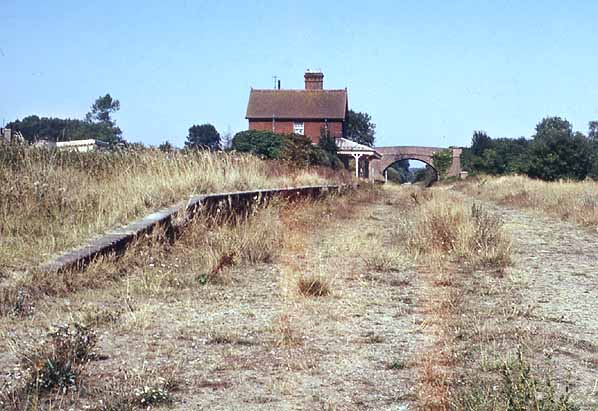
20.jpg)
